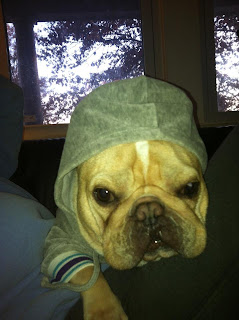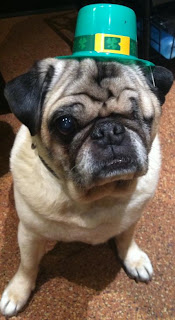As the weather is heating up I want to send a special advisory out to my smushy-faced canine pals. I am talking to the owners of those adorable Pugs, Frenchies, Boston terriers and bulldogs that need to be the most watchful for heat stroke as the temperatures rise. You must know what Brachycephalic Syndrome is so you can keep your dog safe from heat stroke.
The anatomy of brachycephalic (fancy word for smushy-faced) breeds is not compatible with efficient breathing and when combined with high temperatures and humidity can be extremely dangerous. Selecting individuals for breeding that had the most “smushed in” muzzles created these breeds. This then resulted in dogs with highly abnormal airways and excessive soft tissue formation in the throat.
The components of Brachycephalic Airway Disease are as follows:
- Elongated Soft Palate – Through evolution these breed’s noses got pushed back and the soft palpate went with it. As a result the soft palpate is too long for the throat and will intermittently obstruct the windpipe making it difficult to breathe. This causes the dog to struggles to suck in air and over time the soft palate gets even longer making the problem even worse.
- Stenotic Nares – This refers to the size of the dog’s nostrils. If you look at the nose of a brachycephalic dog you will usually see two slits rather than nice oval openings as in non-brachycephalic dogs. To see why this is a problem, I will ask you to lightly pinch your own nostrils, obstructing them just a bit and breathe deeply. You should notice how much more difficult it is inhaling than with normal wide open nostrils. Once again this causes the dog to struggle to breathe in which creates increased negative pressure in the throat adding to the elongation of the soft palate.
- Everted Laryngeal Saccules – These are two meaty clumps of soft tissue that normally sit on either side of the windpipe tucked out of the way. With the constant negative pressure created by the above two conditions these pop into the throat and can further obstruct the trachea.
- Hypoplastic Trachea – The trachea, also know as your windpipe, is a hollow tube and the entrance to the lungs. Brachycephalic breeds are born with a very narrow trachea, which serves to limit airflow into the lungs. Think about the difference in breathing normally verse trying to suck in air through a straw.
 |
| Crash the French Bulldog |
I hope you can see from the above descriptions that brachycephalic breeds are not designed to breathe easily. If you then consider that the main way a dog dissipates body heat is by panting you can see how these breeds can so easily and so quickly overheat.
Here is where the cool part of preventative medicine comes in! We can help minimize and at times even prevent Brachycephalic Airway Disease. The best time to start is when your dog is young, before too much damage has occurred. At Friendship we recommend that at the time of spay or neuter all brachycephalic breeds have their stenotic nares widened and their soft palate evaluated to see if it needs to be shortened.
These two simple procedures can go a long way to helping your adorable smushy-faced friend enjoy the warm weather AND live a longer, more comfortable life. Sounds like a win-win to me!









No comments:
Post a Comment